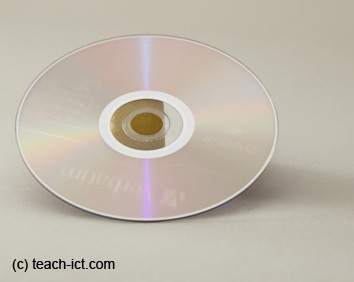7. Compact Disks (CDs)
Compact Disks come in three main forms:
CD-ROM - CD Read Only Memory. This means that when you buy the disk, it already has the data or program stored on it. You can read it, but can't save to it. An example would be a music CD that you buy from a shop.
 CD-WORM - CD Write Once Read Many. This means that you are able to save to this disk one time, so you can store your data or an application on it of your choice. However, once you have saved onto the disk once, you can access the data many times but can't save onto it again.
CD-WORM - CD Write Once Read Many. This means that you are able to save to this disk one time, so you can store your data or an application on it of your choice. However, once you have saved onto the disk once, you can access the data many times but can't save onto it again.
CD-RW - CD ReWritable. This means that you can save data to your disk over and over again, just like you can with a floppy disk.
Compact disks are known as optical storage devices. Data is burned onto the surface of the disk using a laser beam in the CD drive. A laser beam is also used to read the data stored on the disk.
A typical CD can store around 650 Mb of data - equivalent to 450 floppy disks. The entire contents of four text based encyclopedias (no images) could be stored on a single CD.
Advantages
- Small and portable
- Very cheap to produce
- Most computers can read CDs. If there is no CD drive, a DVD drive can usually read them
- Fairly fast to access the data - quicker than a floppy disk or magnetic tape
Disadvantages
- Fairly fragile, easy to snap or scratch
- Smaller storage capacity than a hard drive or DVD
- Slower to access than the hard disk.
challenge see if you can find out one extra fact on this topic that we haven't already told you
Click on this link: Compact Disk
